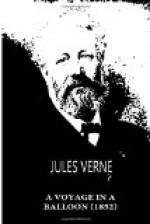The atmosphere grew cooler.
“There is nothing I will not do for you, my host,” said my companion. “If you are cold, I will take off my clothes and lend them to you.”
“Thanks!”
“Necessity makes laws. Give me your hand, I am your countryman. You shall be instructed by my company, and my conversation shall compensate you for the annoyance I have caused you.”
I seated myself, without replying, at the opposite extremity of the car. The young man had drawn from his great coat a voluminous portfolio; it was a work on aerostation.
“I possess,” said he, “a most curious collection of engraving, and caricatures appertaining to our aerial mania. This precious discovery has been at once admired and ridiculed. Fortunately we have passed the period when the Mongolfiers sought to make factitious clouds with the vapour of water; and of the gas affecting electric properties, which they produced by the combustion of clamp straw with chopped wool.”
“Would you detract from the merit of these inventions?” replied I. “Was it not well done to have proved by experiment the possibility of rising in the air?”
“Who denies the glory of the first aerial navigators? Immense courage was necessary to ascend by means of those fragile envelopes which contained only warm air. Besides, has not aerostatic science made great progress since the ascensions of Blanchard? Look, Monsieur.”
He took from his collection an engraving.
“Here is the first aerial voyage undertaken by Pilatre des Rosiers and the Marquis d’Arlandes, four months after the discovery of balloons. Louis XVI. refused his consent to this voyage; two condemned criminals were to have first attempted aerial travelling. Pilatre des Rosiers was indignant at this injustice and, by means of artifice, succeeded in setting out. This car, which renders the management of the balloon easy, had not then been invented; a circular gallery surrounded the lower part of the aerostat. The two aeronauts stationed themselves at the extremities of this gallery. The damp straw with which it was filled encumbered their movements. A chafing-dish was suspended beneath the orifice of the balloon; when the voyagers wished to ascend, they threw, with a long fork, straw upon this brazier, at the risk of burning the machine, and the air, growing warmer, gave to the balloon a new ascensional force. The two bold navigators ascended, on the 21st of November, 1783, from the gardens of La Muette, which the Dauphin had placed at their disposal. The aerostat rose majestically, passed the Isle des Cygnes, crossed the Seine at the Barriere de la Conference, and, directing its way between the dome of the Invalides and L’Ecole Militaire, approached St. Sulpice; then the aeronauts increased the fire, ascended, cleared the Boulevard, and descended beyond the Barriere d’Enfer. As it touched the ground, the collapsed, and buried Pilatre des Rosiers beneath its folds.”




